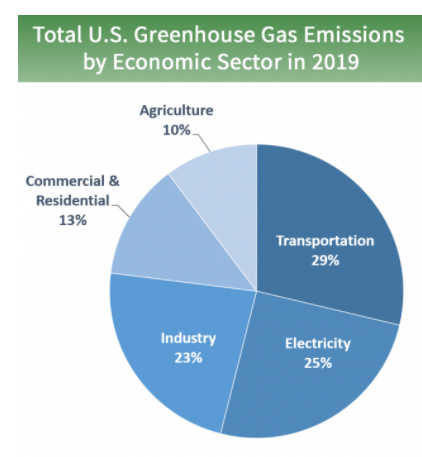Gases that trap heat in the atmosphere are called greenhouse gases (GHG). GHGs include carbon dioxide (CO2), methane (CH4), nitrous oxide (N2O), and fluorinated gases. A carbon footprint is the total amount of GHGs generated by one’s activities. Many activities, including but not limited to electricity consumption, commute to work, facility maintenance, waste disposal, etc. generate GHG emissions. Together these emissions make up one’s carbon footprint.
The graph below demonstrates the main sources of CO2 emissions in the United States:

EPA Mandatory GHG Reporting:
Title 40 of the Code of Federal Regulations (CFR), Part 98, establishes mandatory GHG reporting requirements for owners and operators of certain facilities that directly emit GHG as well as for certain suppliers.
California Mandatory GHG Reporting:
The Climate Change subchapter of the California Code of Regulations (CCR) also requires certain owners and operators to report their GHG emissions annually. Third-party verification is required for each reporting entity that exceeds the applicable thresholds.
California Environmental Quality Act (CEQA):
In California, all projects undertaken by a public agency are subject to CEQA. This includes projects undertaken by any state or local agency, any special district (e.g., a school district), and any public college or university. CEQA also applies to discretionary projects undertaken by private parties. A discretionary project is one that requires the exercise of judgement or deliberation by a public agency in determining whether the project will be approved, or if a permit will be issued.
The CEQA requires government agencies to inform decision-makers and the public about the potential environmental impacts of proposed projects and to reduce those environmental impacts to the extent feasible. Local Air Districts have established a set of CEQA Thresholds of Significance. To determine if GHG emissions from affected projects are significant, project emissions need to be calculated for direct and indirect emissions during construction and operational phases of the proposed project and compared to the applicable thresholds.
NV5’s experienced regulatory compliance specialists can assist in determining if a facility meets the applicability requirements of the GHG reporting regulations. We can help facilities calculate their GHG emissions using applicable equations and methodologies, prepare reports, and assist them in the verification process. We can help businesses determine if their GHG emissions from affected projects are significant for CEQA purposes and if they are, we can propose mitigation measures that would reduce their impact to less than significant levels.
If you have any questions or need more information, please contact Tina Darjazanie at (310) 415-4784.

